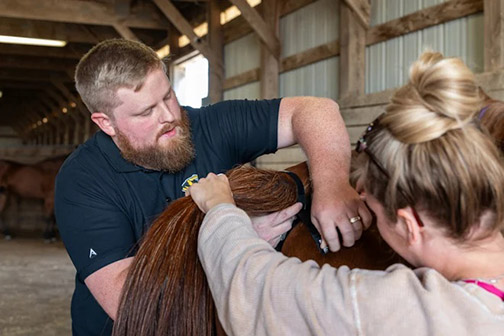By Mary Dillon
COLUMBIA, Mo. — While talking to horses and other animals seems like a far-fetched fantasy, University of Missouri engineers are developing technology that puts us one step closer to that reality.
Doctoral student Morgan Miller and Associate Professor of Mechanical Engineering Jian “Javen” Lin are developing non-invasive sensors that monitor the vital signs of horses both individually and as a group. They’ve also partnered with Mizzou’s Equine Teaching Facility, part of the Division of Animal Sciences, to test the sensors and work with specialists, including Equine Program Director Marci Crosby, to understand what the data they collect can tell equine managers and veterinary professionals.

University of Missouri doctoral student Morgan Miller and Mikaela Adams, manager at the MU Equine Teaching Facility, work together to put a sensor on a horse’s tail.
“This is a new type of technology that can open new opportunities for veterinarians to treat horses,” Lin said. “I believe we, at Mizzou, are the first to use this type of device to study horses’ behavior. It will be interesting to understand animals’ intentions based on their vital signs.”
Miller grew up around horses at his grandparents’ horse farm, Plainview Stables, in Belton, Missouri. When exploring ways to apply biosensors to horses, Miller reached out to faculty in the CAFNR Division of Animal Sciences about partnering with the MU Equine Teaching Facility.
“I was excited to try to help animals that can’t necessarily help themselves,” he said. “We’re trying to expand the field by providing people who work with horses access to more data from which to find more insight into the animals’ wellbeing.”
Improving animal welfare
The team has already seen success from this new technology. In the past four years, they’ve published four papers about the sensors and are working on a fifth one using a third-generation sensor design to identify and predict signs of labor in pregnant horses. The first sensor developed by Lin and Miller was a heart rate monitor deployed on the underside of a horse’s tail. The project served as foundational work for the second-generation sensor that was recently detailed in an Institute of Electrical and Electronics Engineers (IEEE) publication.
“The second-generation sensor uses a networked system,” Lin said. “Multiple sensors are applied to numerous horses to assess the herd’s behavior. The device collects data on the horse’s heart rate, GPS location and acceleration, as well as gyroscopic data to register tail movement.”
Thanks to the partnership with the MU Equine Teaching Facility, the research team would equip four to five horses with the networked sensors during their normal grazing time in the field at Mizzou’s South Farm. They’d then monitor the data to identify changes in vitals and location throughout the day, speaking with researchers at the training facility to understand why the horses behaved as they did.
“We can use this data to look at horses’ environments and make suggestions about how to make them the most comfortable and give them a better quality of life,” Miller said. “We can also use the health data to monitor early disease onset and provide better care for the animals.”
Miller recently wrapped up his doctoral program — he plans to walk at graduation in December — and said he’s enjoyed the challenges that this type of work brings.
“We’ve done human testing with biosensors before, and for the most part, human testing is fairly easy,” he said. “I can tell a person what we need them to do to get results. I can’t explain that to a horse. That’s been a fun challenge to overcome —learning how to adapt my technology to work well with them, because I can’t adapt them to work well with my technology.”
Lin emphasized that even though the team has been focused on working with horses, this type of work has the potential to eventually improve the welfare of other animals, including household pets and endangered species. Their goal is to commercialize the sensors to make them widely available for veterinarians, facility managers and pet parents. Recently, the team has received a National Science Foundation STTR grant to help them achieve the goal.
“We want this research out in the world, creating a better world for all animals,” Lin said. “Working with students like Morgan is what makes my job at Mizzou so fulfilling. Our students bring their own passions to their research and that is the best way to develop something new.”
